2019 MERCEDES-BENZ GLA air condition
[x] Cancel search: air conditionPage 162 of 346
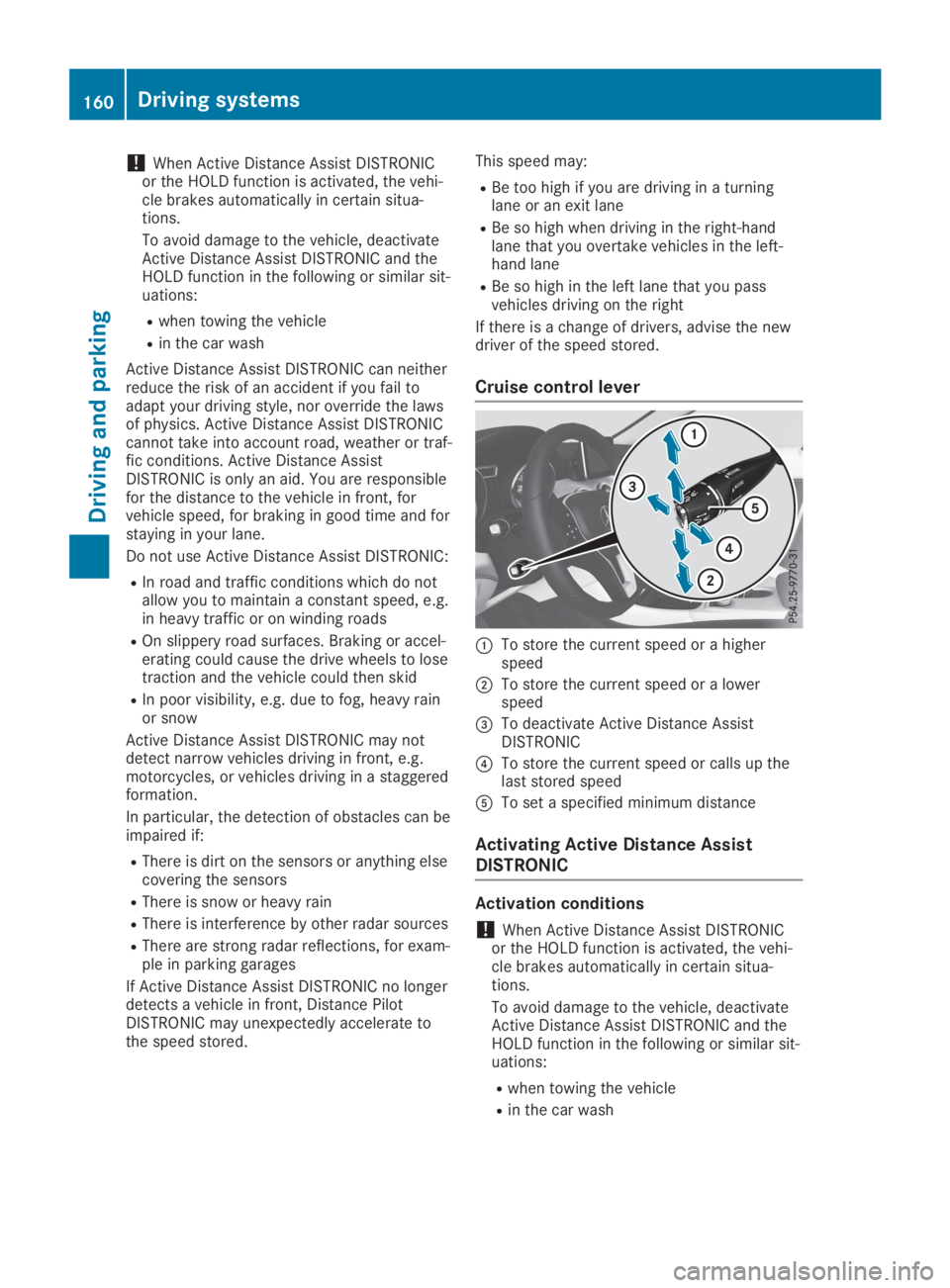
!When Active Distance Assist DISTRONICor the HOLD function is activated, the vehi-cle brakes automatically in certain situa-tions.
To avoid damage to the vehicle, deactivateActive Distance Assist DISTRONIC and theHOLD function in the following or similar sit-uations:
Rwhen towing the vehicle
Rin the car wash
Active Distance Assist DISTRONIC can neitherreduce the risk of an accident if you fail toadapt your driving style, nor override the lawsof physics. Active Distance Assist DISTRONICcannot take into account road, weather or traf-fic conditions. Active Distance AssistDISTRONIC is only an aid. You are responsiblefor the distance to the vehicle in front, forvehicle speed, for braking in good time and forstaying in your lane.
Do not use Active Distance Assist DISTRONIC:
RIn road and traffic conditions which do notallow you to maintain a constant speed, e.g.in heavy traffic or on winding roads
ROn slippery road surfaces. Braking or accel-erating could cause the drive wheels to losetraction and the vehicle could then skid
RIn poor visibility, e.g. due to fog, heavy rainor snow
Active Distance Assist DISTRONIC may notdetect narrow vehicles driving in front, e.g.motorcycles, or vehicles driving in a staggeredformation.
In particular, the detection of obstacles can beimpaired if:
RThere is dirt on the sensors or anything elsecovering the sensors
RThere is snow or heavy rain
RThere is interference by other radar sources
RThere are strong radar reflections, for exam-ple in parking garages
If Active Distance Assist DISTRONIC no longerdetects a vehicle in front, Distance PilotDISTRONIC may unexpectedly accelerate tothe speed stored.
This speed may:
RBe too high if you are driving in a turninglane or an exit lane
RBe so high when driving in the right-handlane that you overtake vehicles in the left-hand lane
RBe so high in the left lane that you passvehicles driving on the right
If there is a change of drivers, advise the newdriver of the speed stored.
Cruise control lever
�CTo store the current speed or a higherspeed
�DTo store the current speed or a lowerspeed
�
Page 187 of 346

still detects increasing lapses in concentra-tion, you will be warned again after 15 minutesat the earliest. This will only happen if ATTEN-TION ASSIST still detects typical indicators offatigue or increasing lapses in concentration.
Vehicles with the COMAND multimediasystem:if a warning is output in the multi-function display, a service station search isperformed in the multimedia system. You canselect a service station and navigation to thisservice station will then begin. This functioncan be activated or deactivated in the multi-media system; see the Digital Operator's Man-ual.
Lane Tracking package
General notes
The Lane Tracking package consists of BlindSpot Assist (Ypage 185) and Lane KeepingAssist (Ypage 186).
Blind Spot Assist
General notes
Blind Spot Assist monitors the areas on eitherside of the vehicle that are not visible to thedriver with two lateral, rear-facing radar sen-sors. A warning display in the exterior mirrorsdraws your attention to vehicles detected inthe monitored area. If you then switch on thecorresponding turn signal to change lane, youwill also receive an optical and audible warn-ing.
Blind Spot Assist supports you from a speed ofapproximately 20 mph (30 km/h).
Important safety notes
GWARNING
Blind Spot Assist does not react to:
Rvehicles overtaken too closely on the side,
placing them in the blind spot area
Rvehicles which approach with a large
speed differential and overtake your vehi-
cle
As a result, Blind Spot Assist may not give
warnings in such situations. There is a risk
of an accident.
Always observe the traffic conditions care-
fully, and maintain a safe lateral distance.
Blind Spot Assist is only an aid. It may fail todetect some vehicles and is no substitute forattentive driving. Always ensure that there issufficient distance to the side for other roadusers and obstacles.
iUSA only:
This device has been approved by the FCCas a "Vehicular Radar System". The radarsensor is intended for use in an automotiveradar system only. Removing, tamperingwith, or altering the device will void any war-ranties, and is not permitted by the FCC. Donot tamper with, alter, or use in any non-approved way.
Any unauthorized modification to this devicecould void the user’s authority to operatethe equipment.
Radar sensors
The radar sensors for Blind Spot Assist areintegrated into the rear bumper. Make surethat the bumpers are free from dirt, ice orslush. The sensors must not be covered, forexample by cycle racks or overhanging loads.Following a severe impact or in the event ofdamage to the bumpers, have the function ofthe radar sensors checked at a qualified spe-cialist workshop. Blind Spot Assist may no lon-ger work properly.
Monitoring range of the sensors
In particular, the detection of obstacles can beimpaired if:
Rthere is dirt on the sensors or anything elsecovering the sensors
Rthere is poor visibility, e.g. due to fog, heavyrain or snow
Ra narrow vehicle traveling in front, e.g. amotorbike or bicycle
Rthe road has very wide lanes
Rthe road has narrow lanes
Ryou are not driving in the middle of the lane
Rthere are barriers or other road boundaries
Vehicles in the monitoring range are then notindicated.
Blind Spot Assist monitors the area up to 10 ft(3 m) behind your vehicle and directly next toit.
Driving systems185
Driving and parking
Z
Page 189 of 346
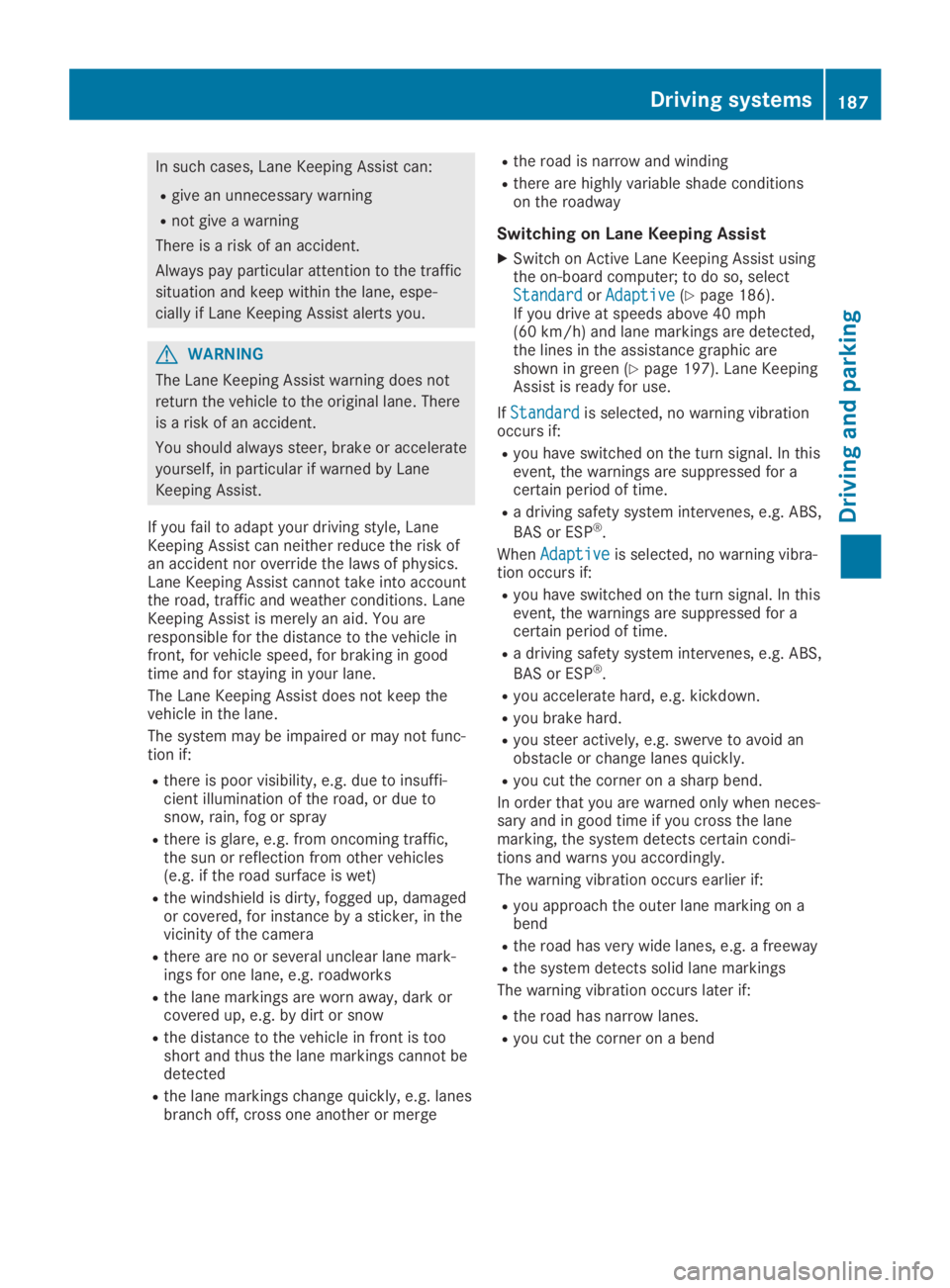
In such cases, Lane Keeping Assist can:
Rgive an unnecessary warning
Rnot give a warning
There is a risk of an accident.
Always pay particular attention to the traffic
situation and keep within the lane, espe-
cially if Lane Keeping Assist alerts you.
GWARNING
The Lane Keeping Assist warning does not
return the vehicle to the original lane. There
is a risk of an accident.
You should always steer, brake or accelerate
yourself, in particular if warned by Lane
Keeping Assist.
If you fail to adapt your driving style, LaneKeeping Assist can neither reduce the risk ofan accident nor override the laws of physics.Lane Keeping Assist cannot take into accountthe road, traffic and weather conditions. LaneKeeping Assist is merely an aid. You areresponsible for the distance to the vehicle infront, for vehicle speed, for braking in goodtime and for staying in your lane.
The Lane Keeping Assist does not keep thevehicle in the lane.
The system may be impaired or may not func-tion if:
Rthere is poor visibility, e.g. due to insuffi-cient illumination of the road, or due tosnow, rain, fog or spray
Rthere is glare, e.g. from oncoming traffic,the sun or reflection from other vehicles(e.g. if the road surface is wet)
Rthe windshield is dirty, fogged up, damagedor covered, for instance by a sticker, in thevicinity of the camera
Rthere are no or several unclear lane mark-ings for one lane, e.g. roadworks
Rthe lane markings are worn away, dark orcovered up, e.g. by dirt or snow
Rthe distance to the vehicle in front is tooshort and thus the lane markings cannot bedetected
Rthe lane markings change quickly, e.g. lanesbranch off, cross one another or merge
Rthe road is narrow and winding
Rthere are highly variable shade conditionson the roadway
Switching on Lane Keeping Assist
XSwitch on Active Lane Keeping Assist usingthe on-board computer; to do so, selectStandardStandardorAdaptiveAdaptive(Ypage 186).If you drive at speeds above 40 mph(60 km/h) and lane markings are detected,the lines in the assistance graphic areshown in green (Ypage 197). Lane KeepingAssist is ready for use.
IfStandardStandardis selected, no warning vibrationoccurs if:
Ryou have switched on the turn signal. In thisevent, the warnings are suppressed for acertain period of time.
Ra driving safety system intervenes, e.g. ABS,
BAS or ESP®.
WhenAdaptiveAdaptiveis selected, no warning vibra-tion occurs if:
Ryou have switched on the turn signal. In thisevent, the warnings are suppressed for acertain period of time.
Ra driving safety system intervenes, e.g. ABS,
BAS or ESP®.
Ryou accelerate hard, e.g. kickdown.
Ryou brake hard.
Ryou steer actively, e.g. swerve to avoid anobstacle or change lanes quickly.
Ryou cut the corner on a sharp bend.
In order that you are warned only when neces-sary and in good time if you cross the lanemarking, the system detects certain condi-tions and warns you accordingly.
The warning vibration occurs earlier if:
Ryou approach the outer lane marking on abend
Rthe road has very wide lanes, e.g. a freeway
Rthe system detects solid lane markings
The warning vibration occurs later if:
Rthe road has narrow lanes.
Ryou cut the corner on a bend
Driving systems187
Driving and parking
Z
Page 190 of 346
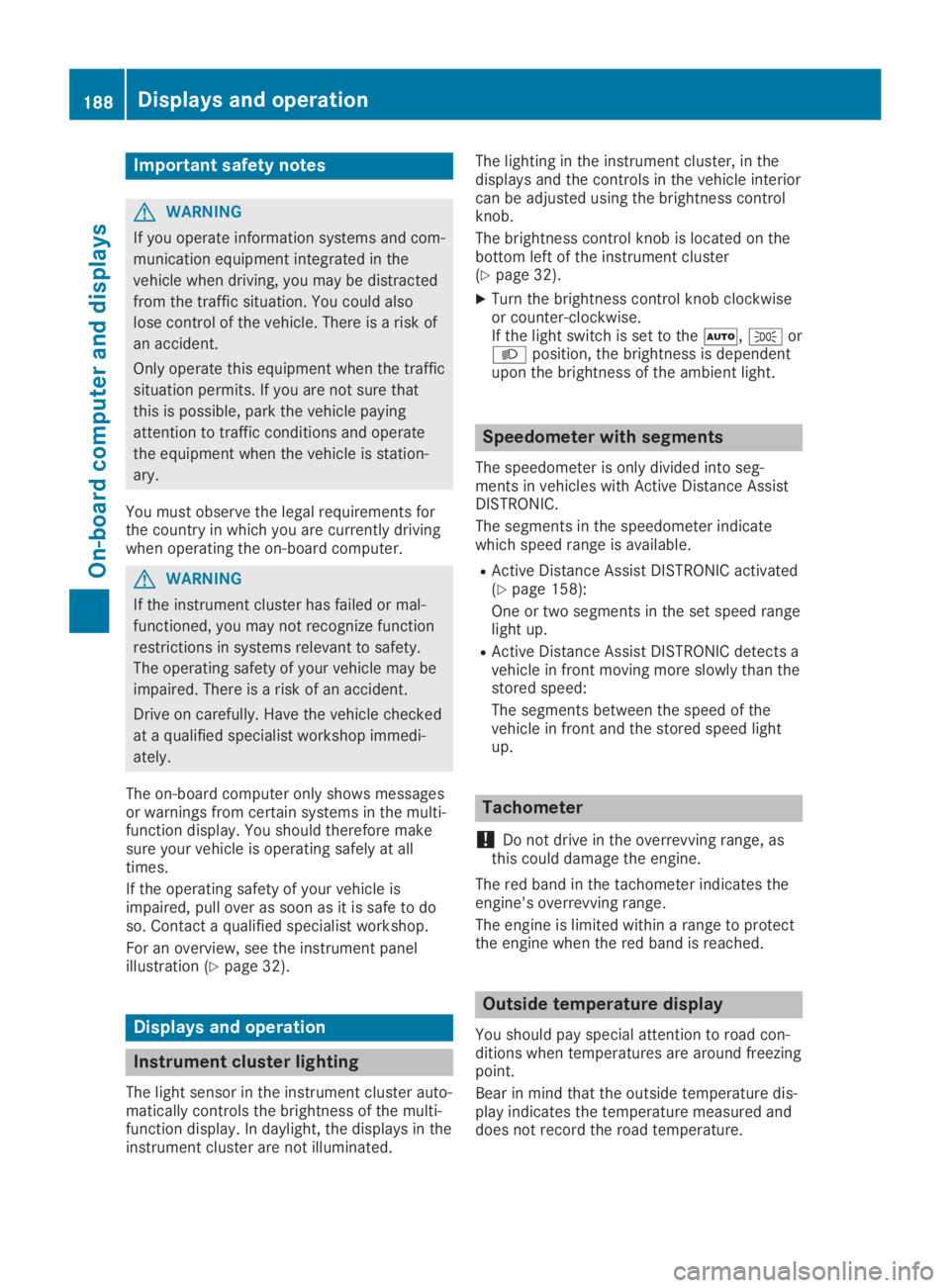
Important safety notes
GWARNING
If you operate information systems and com-
munication equipment integrated in the
vehicle when driving, you may be distracted
from the traffic situation. You could also
lose control of the vehicle. There is a risk of
an accident.
Only operate this equipment when the traffic
situation permits. If you are not sure that
this is possible, park the vehicle paying
attention to traffic conditions and operate
the equipment when the vehicle is station-
ary.
You must observe the legal requirements forthe country in which you are currently drivingwhen operating the on-board computer.
GWARNING
If the instrument cluster has failed or mal-
functioned, you may not recognize function
restrictions in systems relevant to safety.
The operating safety of your vehicle may be
impaired. There is a risk of an accident.
Drive on carefully. Have the vehicle checked
at a qualified specialist workshop immedi-
ately.
The on-board computer only shows messagesor warnings from certain systems in the multi-function display. You should therefore makesure your vehicle is operating safely at alltimes.
If the operating safety of your vehicle isimpaired, pull over as soon as it is safe to doso. Contact a qualified specialist workshop.
For an overview, see the instrument panelillustration (Ypage 32).
Displays and operation
Instrument cluster lighting
The light sensor in the instrument cluster auto-matically controls the brightness of the multi-function display. In daylight, the displays in theinstrument cluster are not illuminated.
The lighting in the instrument cluster, in thedisplays and the controls in the vehicle interiorcan be adjusted using the brightness controlknob.
The brightness control knob is located on thebottom left of the instrument cluster(Ypage 32).
XTurn the brightness control knob clockwiseor counter-clockwise.If the light switch is set to the�X,�`or�Xposition, the brightness is dependentupon the brightness of the ambient light.
Speedometer with segments
The speedometer is only divided into seg-ments in vehicles with Active Distance AssistDISTRONIC.
The segments in the speedometer indicatewhich speed range is available.
RActive Distance Assist DISTRONIC activated(Ypage 158):
One or two segments in the set speed rangelight up.
RActive Distance Assist DISTRONIC detects avehicle in front moving more slowly than thestored speed:
The segments between the speed of thevehicle in front and the stored speed lightup.
Tachometer
!Do not drive in the overrevving range, asthis could damage the engine.
The red band in the tachometer indicates theengine's overrevving range.
The engine is limited within a range to protectthe engine when the red band is reached.
Outside temperature display
You should pay special attention to road con-ditions when temperatures are around freezingpoint.
Bear in mind that the outside temperature dis-play indicates the temperature measured anddoes not record the road temperature.
188Displays and operation
On-board computer and displays
Page 211 of 346
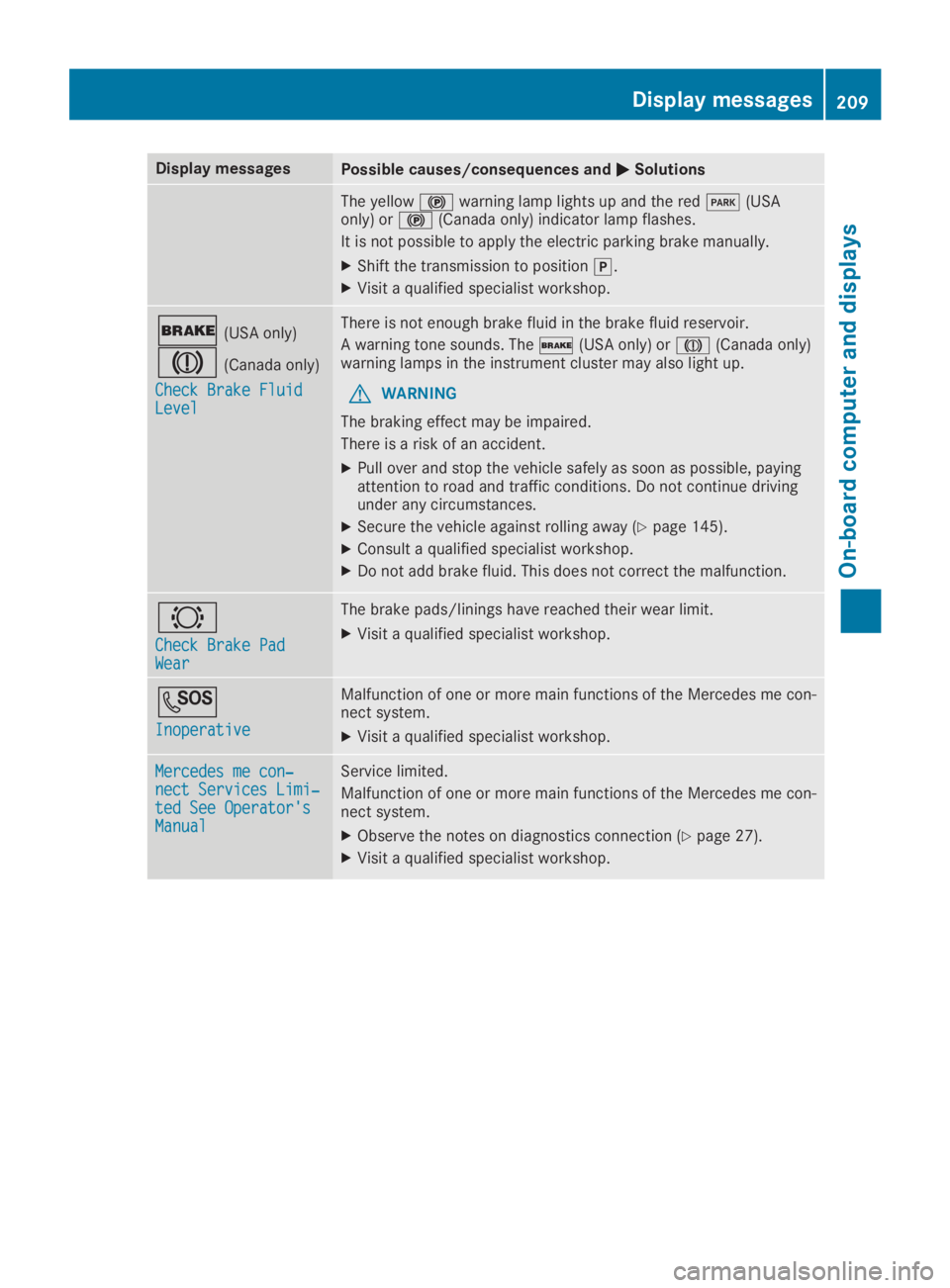
Display messagesPossible causes/consequences and�P�PSolutions
The yellow�$warning lamp lights up and the red�I(USAonly) or�$(Canada only) indicator lamp flashes.
It is not possible to apply the electric parking brake manually.
XShift the transmission to position�].
XVisit a qualified specialist workshop.
�'(USA only)
�M(Canada only)
Check Brake FluidCheck Brake FluidLevelLevel
There is not enough brake fluid in the brake fluid reservoir.
A warning tone sounds. The�'(USA only) or�M(Canada only)warning lamps in the instrument cluster may also light up.
GWARNING
The braking effect may be impaired.
There is a risk of an accident.
XPull over and stop the vehicle safely as soon as possible, payingattention to road and traffic conditions. Do not continue drivingunder any circumstances.
XSecure the vehicle against rolling away (Ypage 145).
XConsult a qualified specialist workshop.
XDo not add brake fluid. This does not correct the malfunction.
�&
Check Brake PadCheck Brake PadWearWear
The brake pads/linings have reached their wear limit.
XVisit a qualified specialist workshop.
�S
InoperativeInoperative
Malfunction of one or more main functions of the Mercedes me con-nect system.
XVisit a qualified specialist workshop.
Mercedes me con‐Mercedes me con‐nect Services Limi‐nect Services Limi‐ted See Operator'sted See Operator'sManualManual
Service limited.
Malfunction of one or more main functions of the Mercedes me con-nect system.
XObserve the notes on diagnostics connection (Ypage 27).
XVisit a qualified specialist workshop.
Displaymessages209
On-b oard computer and displays
Z
Page 214 of 346
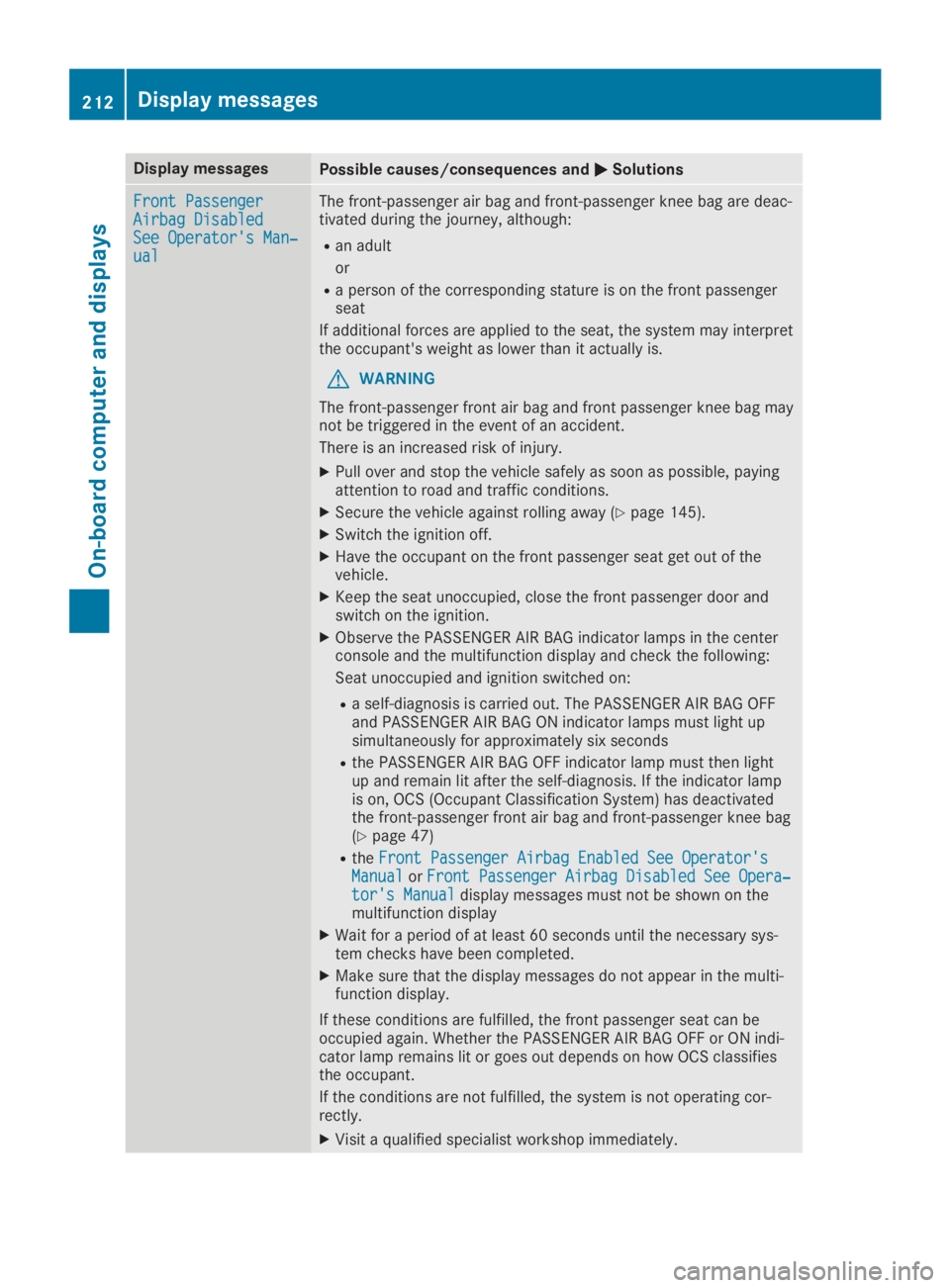
Display messagesPossible causes/consequences and�P�PSolutions
Front PassengerFront PassengerAirbag DisabledAirbag DisabledSee Operator's Man‐See Operator's Man‐ualual
The front-passenger air bag and front-passenger knee bag are deac-tivated during the journey, although:
Ran adult
or
Ra person of the corresponding stature is on the front passengerseat
If additional forces are applied to the seat, the system may interpretthe occupant's weight as lower than it actually is.
GWARNING
The front-passenger front air bag and front passenger knee bag maynot be triggered in the event of an accident.
There is an increased risk of injury.
XPull over and stop the vehicle safely as soon as possible, payingattention to road and traffic conditions.
XSecure the vehicle against rolling away (Ypage 145).
XSwitch the ignition off.
XHave the occupant on the front passenger seat get out of thevehicle.
XKeep the seat unoccupied, close the front passenger door andswitch on the ignition.
XObserve the PASSENGER AIR BAG indicator lamps in the centerconsole and the multifunction display and check the following:
Seat unoccupied and ignition switched on:
Ra self-diagnosis is carried out. The PASSENGER AIR BAG OFFand PASSENGER AIR BAG ON indicator lamps must light upsimultaneously for approximately six seconds
Rthe PASSENGER AIR BAG OFF indicator lamp must then lightup and remain lit after the self-diagnosis. If the indicator lampis on, OCS (Occupant Classification System) has deactivatedthe front-passenger front air bag and front-passenger knee bag(Ypage 47)
RtheFront Passenger Airbag Enabled See Operator'sFront Passenger Airbag Enabled See Operator'sManualManualorFront Passenger Airbag Disabled See Opera‐Front Passenger Airbag Disabled See Opera‐tor's Manualtor's Manualdisplay messages must not be shown on themultifunction display
XWait for a period of at least 60 seconds until the necessary sys-tem checks have been completed.
XMake sure that the display messages do not appear in the multi-function display.
If these conditions are fulfilled, the front passenger seat can beoccupied again. Whether the PASSENGER AIR BAG OFF or ON indi-cator lamp remains lit or goes out depends on how OCS classifiesthe occupant.
If the conditions are not fulfilled, the system is not operating cor-rectly.
XVisit a qualified specialist workshop immediately.
212Displaymessages
On-b oard computer and displays
Page 215 of 346
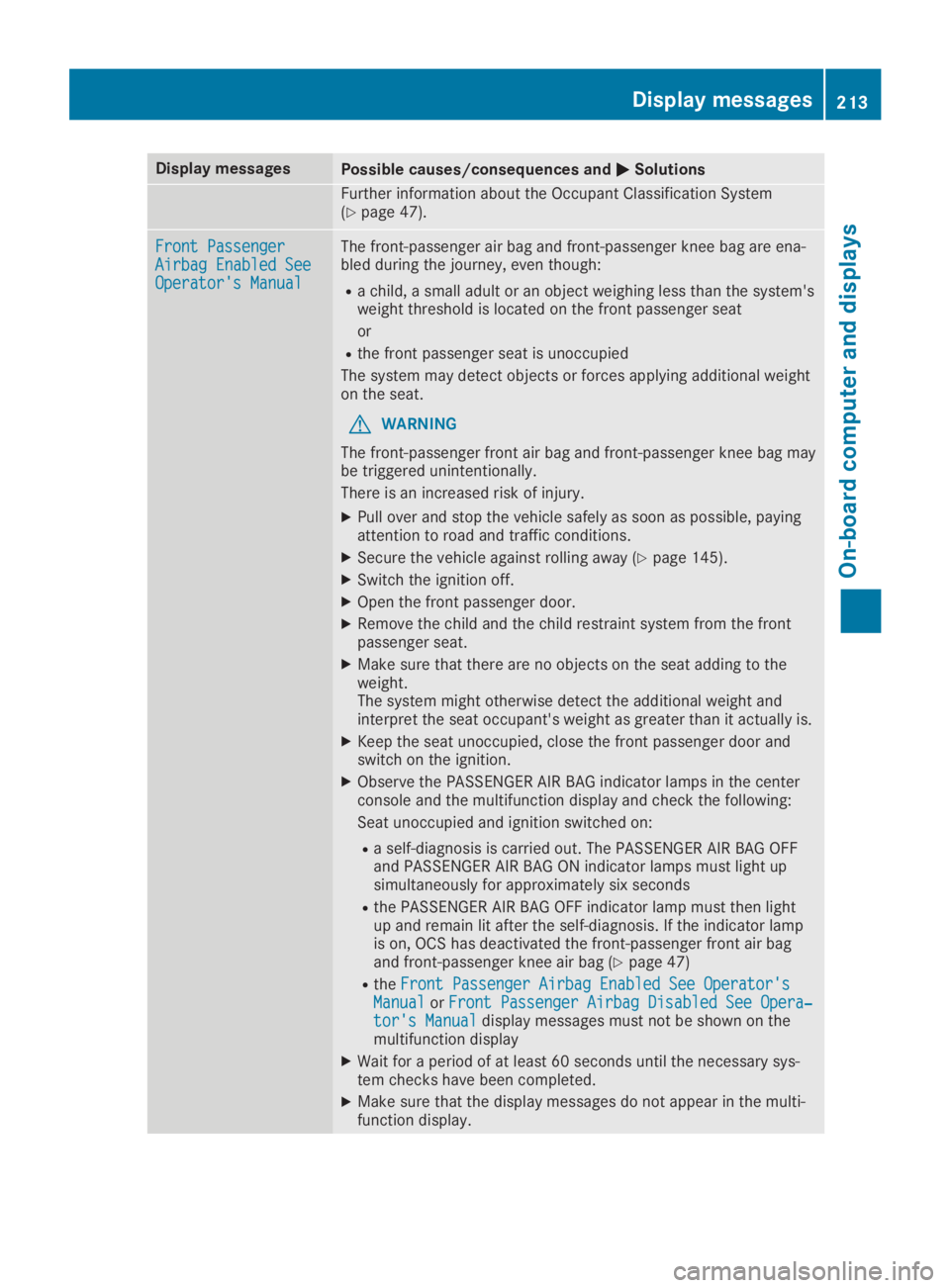
Display messagesPossible causes/consequences and�P�PSolutions
Further information about the Occupant Classification System(Ypage 47).
Front PassengerFront PassengerAirbag Enabled SeeAirbag Enabled SeeOperator's ManualOperator's Manual
The front-passenger air bag and front-passenger knee bag are ena-bled during the journey, even though:
Ra child, a small adult or an object weighing less than the system'sweight threshold is located on the front passenger seat
or
Rthe front passenger seat is unoccupied
The system may detect objects or forces applying additional weighton the seat.
GWARNING
The front-passenger front air bag and front-passenger knee bag maybe triggered unintentionally.
There is an increased risk of injury.
XPull over and stop the vehicle safely as soon as possible, payingattention to road and traffic conditions.
XSecure the vehicle against rolling away (Ypage 145).
XSwitch the ignition off.
XOpen the front passenger door.
XRemove the child and the child restraint system from the frontpassenger seat.
XMake sure that there are no objects on the seat adding to theweight.The system might otherwise detect the additional weight andinterpret the seat occupant's weight as greater than it actually is.
XKeep the seat unoccupied, close the front passenger door andswitch on the ignition.
XObserve the PASSENGER AIR BAG indicator lamps in the centerconsole and the multifunction display and check the following:
Seat unoccupied and ignition switched on:
Ra self-diagnosis is carried out. The PASSENGER AIR BAG OFFand PASSENGER AIR BAG ON indicator lamps must light upsimultaneously for approximately six seconds
Rthe PASSENGER AIR BAG OFF indicator lamp must then lightup and remain lit after the self-diagnosis. If the indicator lampis on, OCS has deactivated the front-passenger front air bagand front-passenger knee air bag (Ypage 47)
RtheFront Passenger Airbag Enabled See Operator'sFront Passenger Airbag Enabled See Operator'sManualManualorFront Passenger Airbag Disabled See Opera‐Front Passenger Airbag Disabled See Opera‐tor's Manualtor's Manualdisplay messages must not be shown on themultifunction display
XWait for a period of at least 60 seconds until the necessary sys-tem checks have been completed.
XMake sure that the display messages do not appear in the multi-function display.
Displaymessages213
On-b oard computer and displays
Z
Page 216 of 346
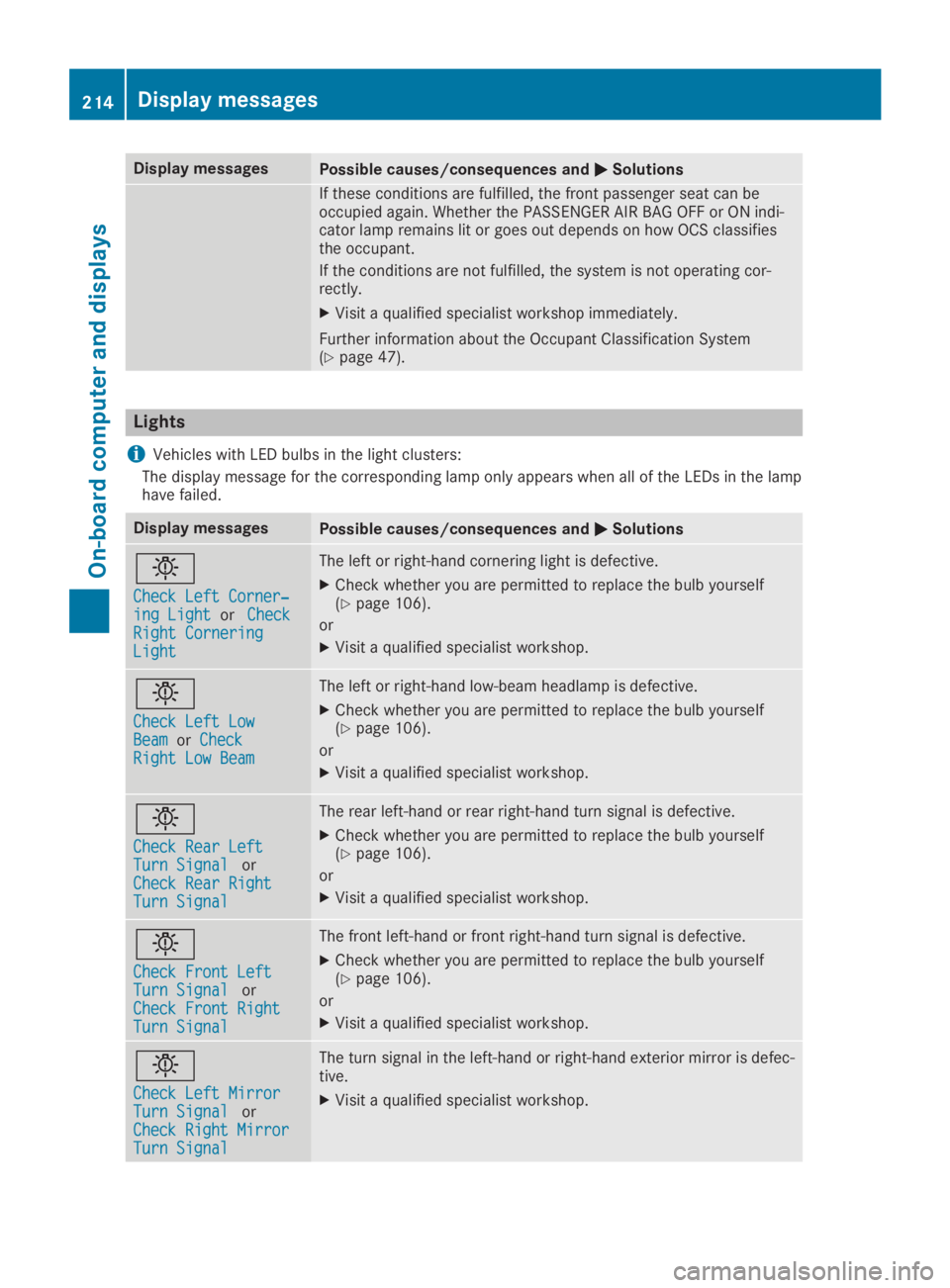
Display messagesPossible causes/consequences and�P�PSolutions
If these conditions are fulfilled, the front passenger seat can beoccupied again. Whether the PASSENGER AIR BAG OFF or ON indi-cator lamp remains lit or goes out depends on how OCS classifiesthe occupant.
If the conditions are not fulfilled, the system is not operating cor-rectly.
XVisit a qualified specialist workshop immediately.
Further information about the Occupant Classification System(Ypage 47).
Lights
iVehicles with LED bulbs in the light clusters:
The display message for the corresponding lamp only appears when all of the LEDs in the lamphave failed.
Display messagesPossible causes/consequences and�P�PSolutions
�I
Check Left Corner‐Check Left Corner‐ing Lighting LightorCheckCheckRight CorneringRight CorneringLightLight
The left or right-hand cornering light is defective.
XCheck whether you are permitted to replace the bulb yourself(Ypage 106).
or
XVisit a qualified specialist workshop.
�I
Check Left LowCheck Left LowBeamBeamorCheckCheckRight Low BeamRight Low Beam
The left or right-hand low-beam headlamp is defective.
XCheck whether you are permitted to replace the bulb yourself(Ypage 106).
or
XVisit a qualified specialist workshop.
�I
Check Rear LeftCheck Rear LeftTurn SignalTurn SignalorCheck Rear RightCheck Rear RightTurn SignalTurn Signal
The rear left-hand or rear right-hand turn signal is defective.
XCheck whether you are permitted to replace the bulb yourself(Ypage 106).
or
XVisit a qualified specialist workshop.
�I
Check Front LeftCheck Front LeftTurn SignalTurn SignalorCheck Front RightCheck Front RightTurn SignalTurn Signal
The front left-hand or front right-hand turn signal is defective.
XCheck whether you are permitted to replace the bulb yourself(Ypage 106).
or
XVisit a qualified specialist workshop.
�I
Check Left MirrorCheck Left MirrorTurn SignalTurn SignalorCheck Right MirrorCheck Right MirrorTurn SignalTurn Signal
The turn signal in the left-hand or right-hand exterior mirror is defec-tive.
XVisit a qualified specialist workshop.
214Displaymessages
On-b oard computer and displays